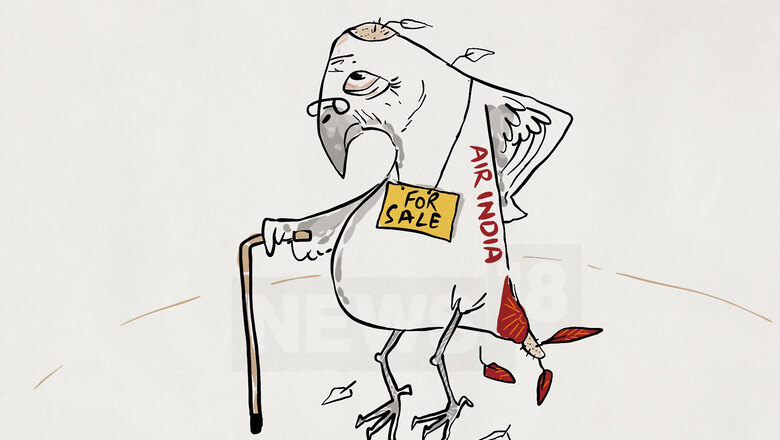
views
There are obvious learnings the government has imbibed from the failed attempt at selling off Air India during its first tenure. The biggest change in the bid conditions, which were unveiled today, is that the government intends to exit the airline completely.
As the divestment process got restarted on Monday, it became clear that the government is seeking to sell 100 per cent equity share capital in the airline, along with Air India’s shareholding interest of 100 per cent in AI Express Limited and 50 per cent in Air India SATS Airport Services Private Limited.
In the previous attempt, the government had offered only 76 per cent equity in the two airline companies, a major roadblock for potential investors.
The second big learning from the cold response that had been seen in the last bidding process is that the total debt the bidder will have to bear has also been reduced significantly. The bid document says only a little over Rs 23,000 crore of debt will be left on the airlines books (which is less than half the debt of AI) and that liabilities outside of the debt would be an additional amount, backed by assets.
Thirdly, this round of disinvestment mandates 3 per cent of the airline equity for employee stock options. It also presents the status of airline employees in a better light compared to other airline peers. The document also says that nearly every third employee of the airline is set to retire in the next five years and that its expense on employees is in the same bracket as market leader IndiGo. But, yet again, there is no mention of any Voluntary Retirement Scheme or any other method by which employee strength can be reduced.
So at least in terms of exiting the airline completely and lessening the employee plus debt burden on the buyer, the government appears to have done well this time.
Some other bid conditions for prospective bidders also seem benign. For example, it wants the acquirer to ensure that AI and Air India Express Limited (AIXL) continue their business "on a going concern basis for a period of three years from the date of the closing of the Proposed Transaction on terms as may be specified in the definitive documents provided the foregoing shall not restrict route rationalization by AI and AIXL or any actions, steps or decisions taken for operational and financial efficiency of AI and AIXL.”
In simple terms, it means the bidder cannot shut down the airline or declare it bankrupt for at least three years. Also, the brand name "Air India" cannot be abandoned by the bidder.
So will the government succeed this time around in getting Air India off its hands? There have been reports of increased interest in this round of disinvestment, with at least one large corporate house likely to throw its hat in the ring.
But glitches remain. There seems to be no relaxation in the 49 per cent cap for foreign airlines to invest in Indian carriers. This means no foreign airline with deep pockets can directly bid for AI - since it would mandatorily need an Indian partner - thereby reducing the number of potential bidders.
The second concern is over the poor airline financials. Air India has been desperately short of cash for much of this fiscal as the government has been reluctant to pump more money into this loss making behemoth. And this severe cash shortage has impacted the airline’s operations. An airline source had earlier said that dues to vendors and creditors till now this fiscal have already crossed the Rs 8,000 crore mark.
Not only is day-to-day operation a struggle, Air India’s finances seem to only worsen with each year. In 2018-19 (the latest available financial data), AI reported an increase of over Rs 3,000 crore in annual losses to post its highest ever net loss of Rs 8,474.8 crore.
This meant AI lost almost Rs 23 crore each day of FY 19 - this is the highest loss since the two erstwhile airlines were merged to form the present entity in 2007. The net loss for FY18 was Rs 5,348 crore.
Also, according to the airline’s auditors, the accumulated losses now stand at a whopping Rs 62,694 crore. AI’s current liabilities exceeded its current assets by Rs 65,245.87 crore as on March 31 this year. Total debt on its books on that date was Rs 58,255.9 crore.
And not only is the airline sinking deeper into losses, its subsidiaries are also not in the pink of health.
As of March this year, Air India had five subsidiaries: AI Express, Alliance Air (domestic low cost), Hotel Corporation of India, Air India Air Transport Services (wholly owned ground handling arm), Air India Engineering Services and AISATS (ground handling joint venture with SATS of Singapore).
During 2018-19, four of these six subsidiaries also reported losses; small profits accrued only from the two ground handling arms. With such precarious finances of Air India, reluctance of large Indian business houses to come forward and the government’s intransigence over foreign airline restrictions, the sale may remain a tough call.
The author is a senior journalist. Views expressed are personal.


















Comments
0 comment